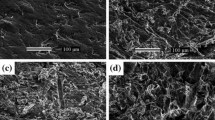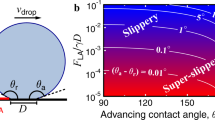Abstract
Material surfaces can be modified to become superhydrophobic using different techniques. Test equipment is necessary to assess the effectiveness of a superhydrophobic surface against frictional drag force. Because the frictional drag force is very small, especially for a sample size to be tested at a laboratory level, a traditional water channel system is not suitable. As a result, a new test setup was designed and fabricated to measure the reduction in the skin frictional drag force on such a superhydrophobic metallic surface. Two different types of sensors were considered. The first one was a spring-based displacement sensor and the other was a spring-less displacement sensor. The developed test setup can have the flow speed with a range of Reynolds numbers up to 70,000 with respect to the test specimen. In this range, the change in the frictional drag force was measured for superhydrophobic surfaces. A microscope was also used to check any change in the air film on the superhydrophobic surface as the flow speed was increased.















Similar content being viewed by others
References
Aljallis E, Sarshar M, Datla R, Sikka V, Jones A, Choi C (2013) Experimental study of skin friction drag reduction on superhydrophobic flat plates in high Reynolds number boundary layer flow. Phys Fluids 25(2):025103
Bhushan B, Jung Y (2006) Micro- and nanoscale characterization of hydrophobic and hydrophilic leaf surfaces. Nanotechnology 17(11):2758–2772
Cassie A, Baxter S (1944) Wettability of porous surfaces. Trans Faraday Soc 40:546–551
Chen W, Fadeev A, Hsieh M, Öner D, Youngblood J, McCarthy TJ (1999) Ultrahydrophobic and ultralyophobic surfaces: some comments and examples. Langmuir 15(10):3395–3399
Cottin-Bizonne C, Cross B, Steinberger A, Charlaix E (2005) Boundary slip on smooth hydrophobic surfaces: intrinsic effects and possible artifacts. Phys Rev Lett 94(5):056102
Daniello R, Waterhouse N, Rothstein J (2009) Drag reduction in turbulent flows over superhydrophobic surfaces. Phys Fluids 21(8):085103
Elbing B, Winkel E, Lay K, Ceccio S, Dowling D, Perlin M (2008) Bubble-induced skin-friction drag reduction and the abrupt transition to air-layer drag reduction. J Fluid Mech 612:201–236
Fukuda K, Tokunaga J, Nobunaga T, Nakatani T, Iwasaki T, Kunitake Y (2000) Frictional drag reduction with air lubricant over a super-water-repellent surface. J Mar Sci Technol 5(3):123–130
Henoch C, Krupenkin TN, Kolodner P, Taylor JA, Hodes MS, Lyons AM, Peguero C, Breuer K (2006) Turbulent drag reduction using superhydrophobic surfaces. In: Collection of technical papers: third AIAA flow control conference, June, San Francisco, California, AIAA 2006-3192
Kietzig A, Hatzikiriakos S, Englezos P (2009) Patterned superhydrophobic metallic surfaces. Langmuir 25(8):4821–4827
Mahadevan L, Pomeau Y (1999) Rolling droplets. Phys Fluids 11(9):2449–2453
Martell MB, Perot JB, Rothstein JP (2009) Direct numerical simulations of turbulent flows over superhydrophobic surfaces. J Fluid Mech 620:31–41
Martell MB, Rothstein JP, Perot JB (2010) An analysis of superhydrophobic turbulent drag reduction mechanisms using direct numerical simulation. Phys Fluids 22:065102
Maynes D, Jeffs K, Woolford B, Webb B (2007) Laminar flow in a microchannel with hydrophobic surface patterned microribs oriented parallel to the flow direction. Phys Fluids 19(9):093603
Min T, Kim J (2004) Effects of hydrophobic surfaces on skin-friction drag. Phys Fluids 16:L55–L58
Min T, Kim J (2005) Effects of hydrophobic surface on stability and transition. Phys Fluids 17:108106
Neinhuis C, Barthlott W (1997) Characterization and distribution of water-repellent, self-cleaning plant surfaces. Ann Bot 79(6):667–677
Ou J, Rothstein J (2005) Direct velocity measurements of the flow past drag-reducing ultrahydrophobic surfaces. Phys Fluids 17(10):103606
Trim A, Braaten H, Lie H, Tognarelli M (2016) Experimental investigation of vortex-induced vibration of long marine risers. J Fluid Struct 21(3):335361
Wang S, Jiang L (2007) Definition of superhydrophobic states. Adv Mater 19(21):3423–3424
Zuhlke CA, Alexander DR, Bruce JC III, Ianno NJ, Kamler CA, Yang W (2010) Self assembled nanoparticle aggregates from line focused femtosecond laser ablation. Opt Express 18(5):4329–4339
Zuhlke CA, Anderson TP, Alexander DR (2013) Formation of multiscale surface structures on nickel via above surface growth and below surface growth mechanisms using femtosecond laser pulses. Opt Express 21(7):8460–8473
Acknowledgements
The superhydrophobic samples were fabricated and provided by Prof. Dennis Alexander at the University of Nabraska–Lincoln, and the financial support was provided by Ms. Sarwat Chappell at the Office of Naval Research. Their supports are greatly appreciated for the present research.
Author information
Authors and Affiliations
Corresponding author
Ethics declarations
Conflict of interest
On behalf of all authors, the corresponding author states that there is no conflict of interest.
Additional information
Publisher's Note
Springer Nature remains neutral with regard to jurisdictional claims in published maps and institutional affiliations.
Rights and permissions
About this article
Cite this article
Ley, J.R., Kwon, Y.W. & Masellas, D. Measurement of frictional drag force on superhydrophobic metallic surface. Multiscale and Multidiscip. Model. Exp. and Des. 2, 15–22 (2019). https://doi.org/10.1007/s41939-018-0019-7
Received:
Accepted:
Published:
Issue Date:
DOI: https://doi.org/10.1007/s41939-018-0019-7




